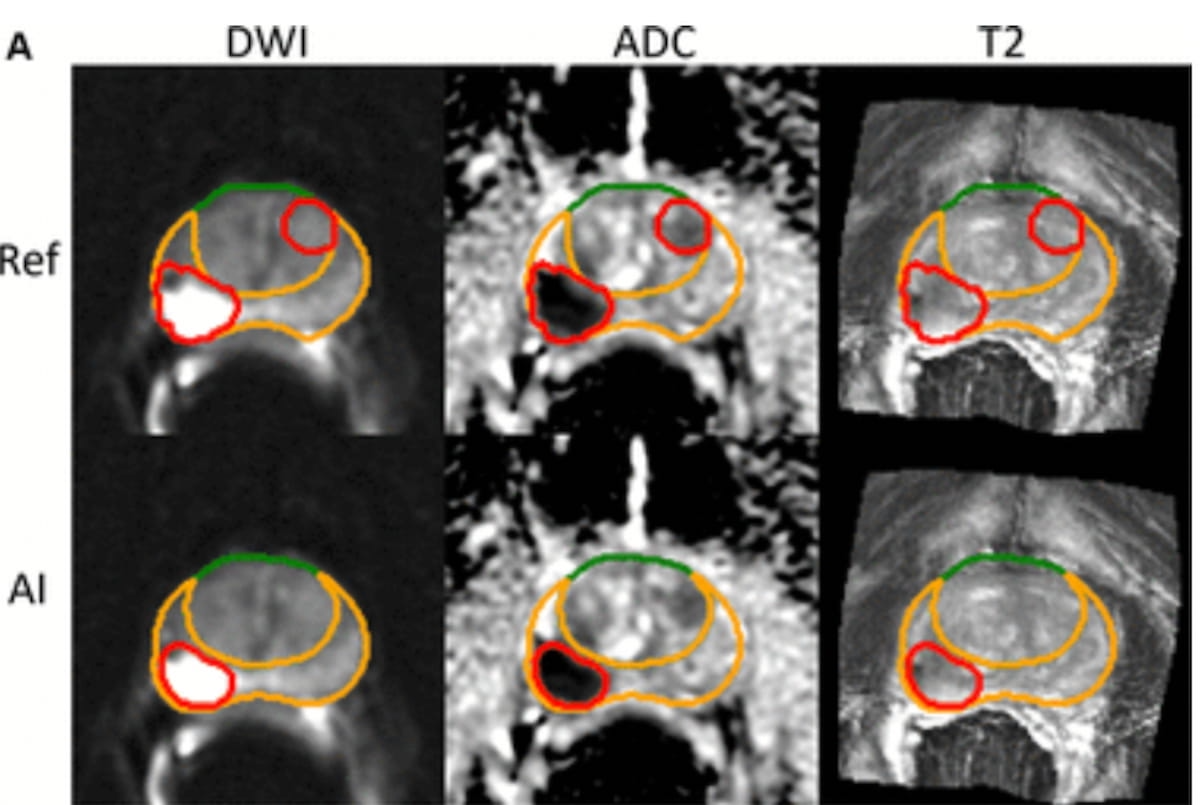Emerging research suggests the use of artificial intelligence (AI) segmentation via multiparametric magnetic resonance imaging (mpMRI) to ascertain total intraprostatic tumor volume may have significant implications in predicting metastasis in patients treated for localized prostate cancer (PCa).
For the retrospective study, recently published in Radiology, researchers developed and trained an AI tumor segmentation algorithm for differentiating Prostate Imaging Reporting and Data System (PI-RADS) 3-5 lesions. The study authors subsequently compared total imtraprostatic tumor volume, generated with the AI segmentation algorithm (VAI), and the National Comprehensive Cancer Network (NCCN) risk categorization for predicting metastasis in 732 patients treated with either radical prostatectomy (RP) or radiotherapy (RT) for localized PCa.
The researchers found that VAI measurement had an 84 percent area under the receiver operating characteristic curve (AUC) for predicting seven-year metastases in the RT group in contrast to 74 percent for the NCCN risk classification. For the RP cohort, the study authors also found that VAI evaluation had a 10 percent higher AUC for predicting metastases within five years (89 percent) than the NCCN classification system (79 percent).
“VAI may have been prognostic because it measured the total burden of clinically significant intraprostatic tumors consistently. Although other MRI measures of tumor burden, such as tumor size, PI-RADS scores, and manually delineated tumor volumes … are also prognostic, they are subject to interobserver variability from benign anatomic changes, imaging artifacts, motion artifacts, and variable soft tissue contrast,” wrote lead study author David D. Yang, M.D., who is affiliated with the Department of Radiation Oncology at Brigham and Women’s Hospital and the Dana Farber Cancer Institute in Boston, and colleagues.
Noting that use of NCCN risk categorization may be prone to differences with biopsy sampling strategies and clinician technique, the study authors maintained that the VAI model promotes better reproducibility and ease of use.
“VAI is a highly interpretable entity as a systematic assessment tool for intraprostatic tumors, visible at MRI, that can be easily cross-checked against human-derived tumor volume. Unlike genomic classifiers or digital pathology approaches, no specific retrieval or handling of clinical specimens is required. Additionally, because VAI determination involves analysis of the entire prostate, under-sampling of aggressive disease may be less likely,” emphasized Yang and colleagues.
Three Key Takeaways
1. AI-assisted tumor volume measurement shows predictive advantage. The AI segmentation model (VAI) demonstrated superior predictive accuracy for metastasis compared to traditional NCCN risk categorization in patients treated with radiotherapy (RT) or radical prostatectomy (RP).
2. Consistent and reproducible measurement. The VAI model may offer a more reproducible method for assessing intraprostatic tumor burden, overcoming limitations associated with other MRI measurements that are prone to variability due to factors like benign anatomic changes and imaging artifacts.
3. Potential to influence treatment decisions. By identifying high-risk patients more accurately, VAI may be a consideration in decision-making for upfront radiotherapy over surgery, especially for patients with aggressive disease who might benefit more from early intervention.
The study authors suggested that utilization of the VAI model may also have an impact on the management of PCa.
“For patients with unfavorable-risk disease, a high likelihood of obtaining clinically significant adverse pathologic findings after prostatectomy, for which adjuvant rather than early-salvage RT may be beneficial, may prompt some patients to choose up-front RT instead,” added Yang and colleagues.
(Editor’s note: For related content, see “Emerging AI Platform Shows Promise for Prostate Cancer Detection on mpMRI,” “Should MRI be Mandatory Prior to Active Surveillance Decisions for Patients with Intermediate Risk Prostate Cancer?” and “MRI Study Suggests Deep Learning Model Offers Equivalent Detection of csPCa as Experienced Radiologists.”)
Beyond the inherent limitations of a single-center retrospective study, the authors acknowledged that patients in the cohort were diagnosed with PCa prior to the broader use of MRI and ultrasound fusion biopsies. They also cautioned that results obtained with the evaluated AI algorithm in this study may not be applicable with different image acquisition settings, or MRI systems from different vendors.
